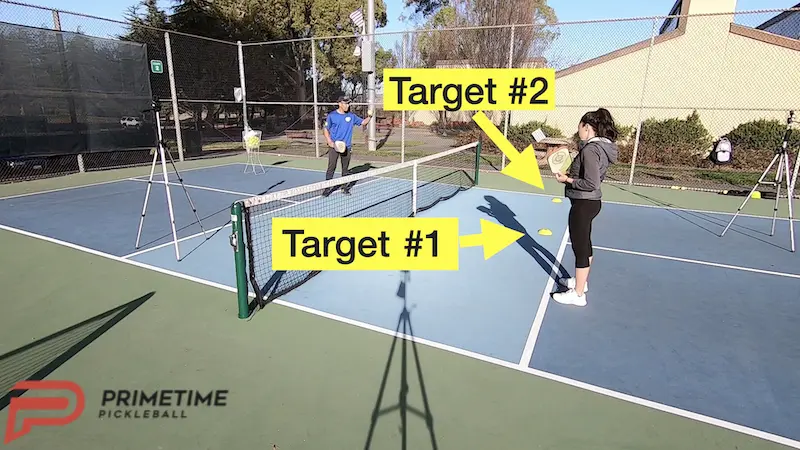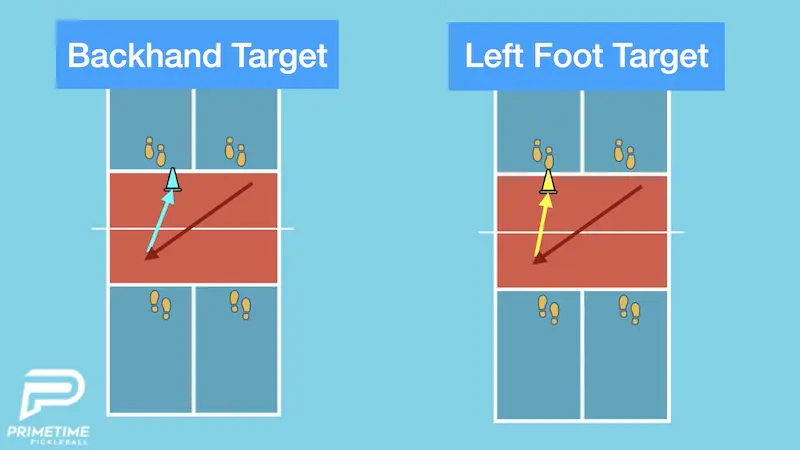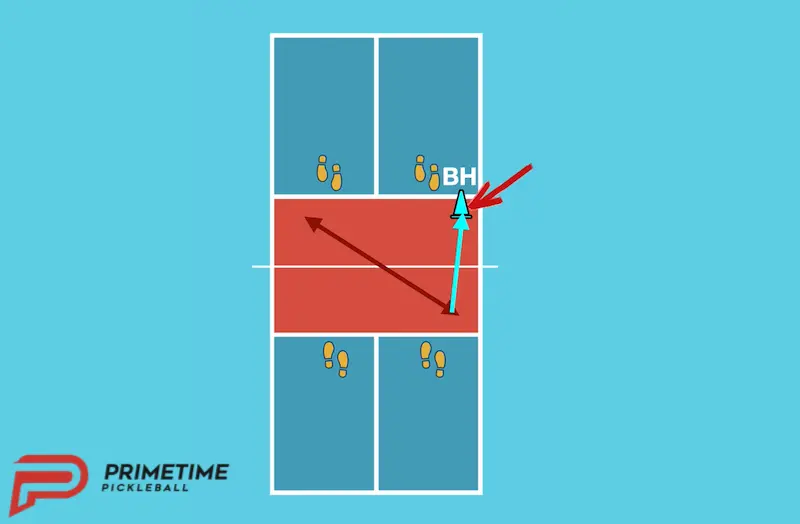You’ve likely heard that in pickleball, one of the best dinks to use is the cross court dink.
We recommend it, as do most coaches, and we’ll recap why that is in today’s video/blog. But, there are conditions under which it’s not necessarily best.
We’re going to cover two specific instances when you should not dink cross court and what you should do instead to improve your odds of winning the point.
Let’s break down the scenario first. In this specific specific video/blog I’m going to be talking about dinking cross-court and redirecting your dinks down the line.
I’m going to show you here on the odd side (see video at top of post). If you’re both right handers you are going to be dinking from the outside of the court, so it’s going to be my backhand, to my opponent’s backhand.
You see this kind of cross-court dinking happening a lot in intermediate and higher levels of play because this is a very high percentage shot. This is due to the fact that the net is lower in the middle, you’re crossing over the lowest part of the of the net, and you have the most margin and room to work with when you are dinking cross court.
Reason #1 For Redirecting – You Are Being “Outdinked” In A Crosscourt Dink Exchange
The first reason that you would want to redirect your dink and not hit it to the person cross court from you is when that person is out dinking you and is a stronger opponent.
If you continue in that cross-court dink rally and you are making mistakes and they are drawing errors or you’re just losing those dink battles that is the first reason you would want to redirect that dink and take that dink somewhere else.
Reason #2 For Redirecting – The Weaker Opponent Is Down The Line From You
The second reason that you would want to redirect your dink and not keep it cross court is when the weaker opponent is in front of you down the line from you.
Instead of going to the stronger player and playing them you would want to redirect that dink, take it down the line, even though you have less margin in the net as it is a little bit higher. You’re going to take that dink down the line because you have a better chance of winning the point if the person down the line from you is weaker and they are taking that shot.
How To Redirect
Now that we talked about why you should redirect your dink I’m going to show you how to do that.
I have my wife Katrina cross-court from me, like that scenario I was talking about earlier, we’re going to dink backhand to backhand. And of course, in a doubles game, I would have my partner here and the other opponent straight ahead from me.
To break up this pattern, I have these two targets here, I have one closer to the sideline and then I have one towards the person in front of me towards their backhand if they’re right-handed player.

These are two good targets to redirect your dink.
The reason why I keep going cross-court is it’s easier to send that ball back from the place that it came from so redirecting your dink at any time is going to be a little bit harder but for those reasons that we just mentioned it could be a good thing.
The number one thing you want to do when you’re redirecting your dink is you just want to make sure that you’re not under a lot of stress or pressure.
If it’s a really tough shot from your opponent that is not the time to redirect your dink.
You want to be in control. You want to make sure that you have good control of your body and that your footwork is good and that is a time where you can redirect it in a controlled way.
This is a good way to practice redirecting your dinks from getting out of that cross-court pattern and redirecting it down the line.
This down the line dink is a good dink because you’re totally redirecting it into a place that is near the sideline which might be unexpected for your opponent but be mindful of your accuracy as there is less margin of safety.
Also, if you’re redirecting it near the sideline you do have to be careful for that Ernie.
Here’s a link for a video regarding Ernie’s – https://primetimepickleball.com/how-to-setup-the-erne-in-pickleball/
This is one thing you have to worry about on this side.
A reason why this could be a good spot is because when you are dinking like this cross court your opponent ahead of you is probably not going to be expecting a redirect dink near the sideline.
The number one target if you’re going to redirect this ball is going to be closer to the middle which is toward the backhand (if they’re a right handed player) of the opponent who’s in front of me.
This is one of the best places to redirect this dink and get out of the cross-court dink rally.
Whether you’re taking this ball as a volley or not, that cone towards the backhand of the player in front of you, is a really good spot to redirect it.
A third option when redirecting the dink from cross court to down the line is instead of going for a more true backhand target on a right-handed player, you also have the option to hit it more towards their left foot and try to jam them up in their backhand side near their body.

This is often a very effective target as it can be hard to handle well and may more easily lead to pop-ups and misses from your opponent.
Let’s take a quick look at how this all plays out on the even side when two players will be in a forehand to forehand dink exchange and you’re looking to move it down the line for the same two reasons that we’ve already mentioned.
The target options here are similar yet the inside dink here will likely be to an opposing player’s forehand if they are right-handed and the sideline dink will be to the opposing player’s backhand. Therefore, on the even side you may want to go for the dink closer to the sideline more often than when redirecting a dink down the line from the odd side in order to exploit the backhand more frequently.

And, you can also opt to dink it more towards the left foot at times which will still be towards their backhand but will also hopefully jam them up and lead to more pop-ups and misses from your opponent which is a similar concept to what we discussed on the odd side as well .
I hope this video is really helpful to you.
Go ahead and go out there and try it with a partner or with a friend.
Happy Pickeling!